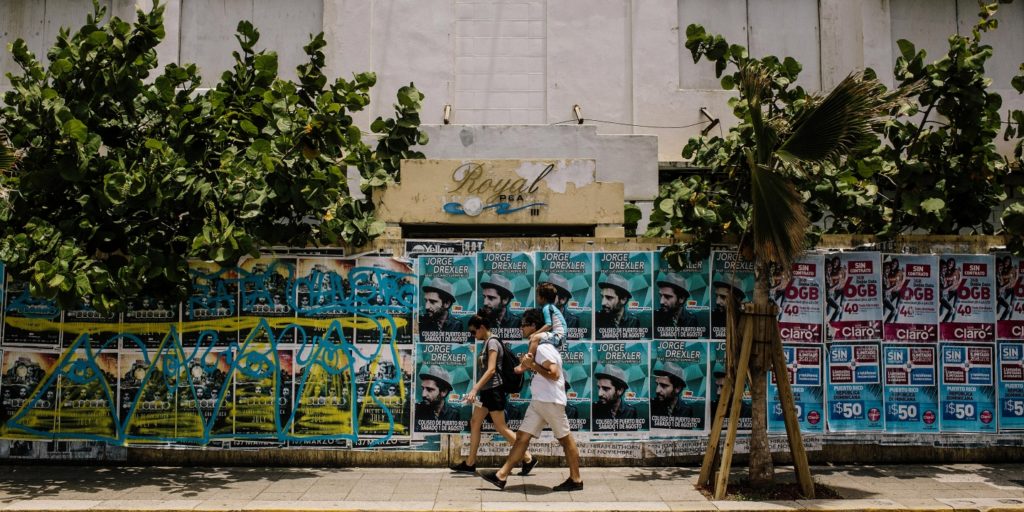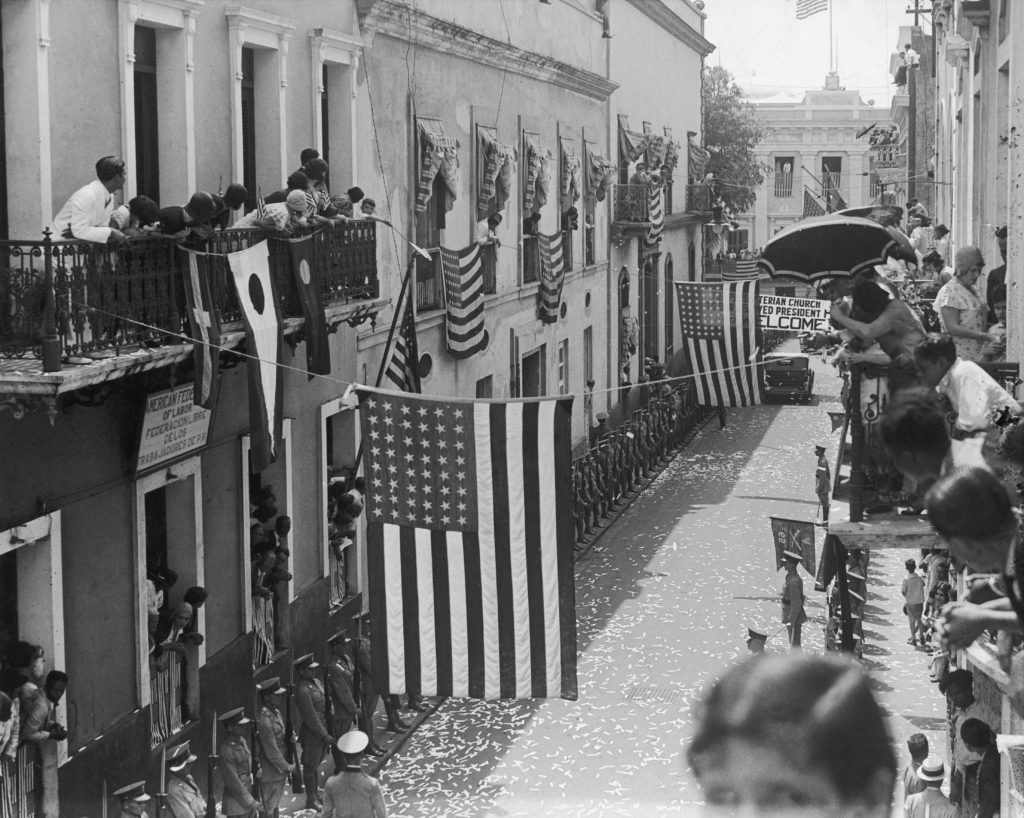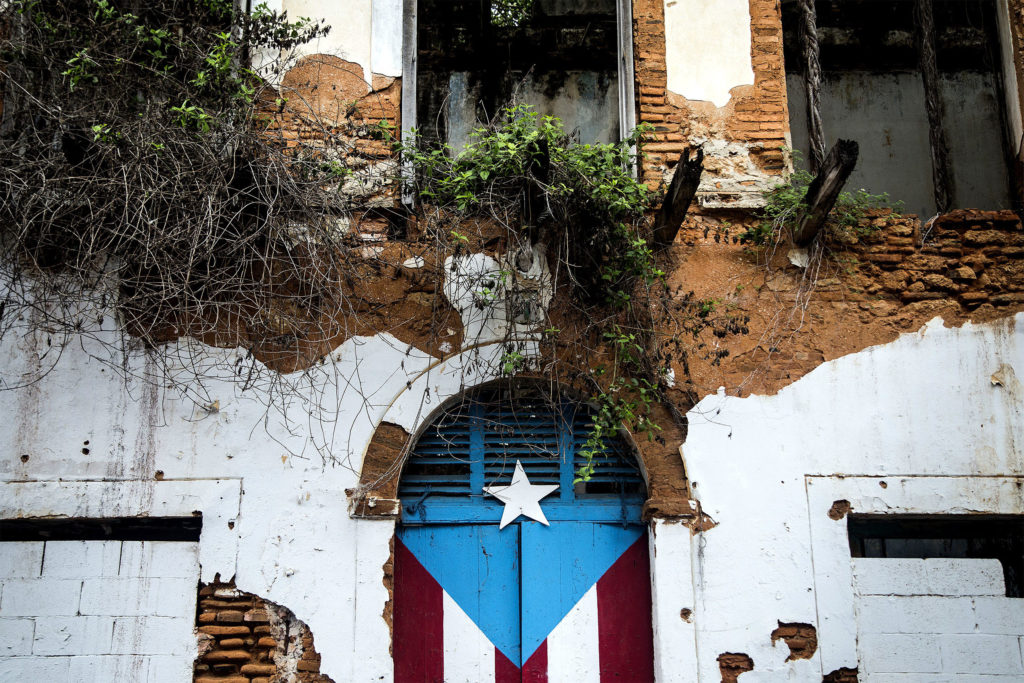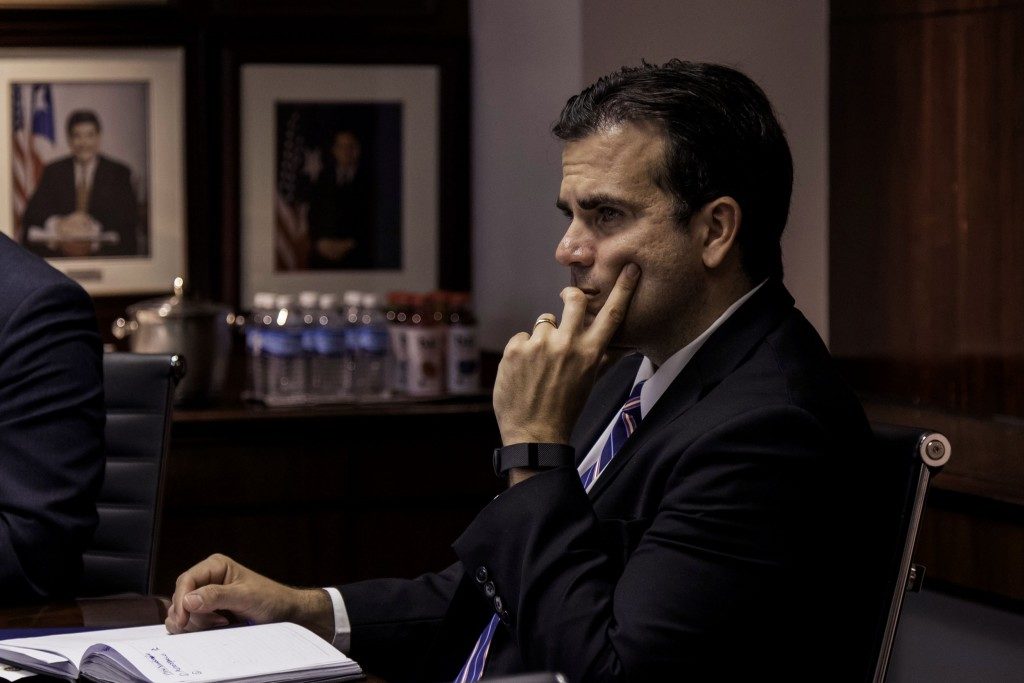Puerto Rico’s $123 Billion Bankruptcy Is the Cost of U.S. Colonialism
ANGLO AMERICA, 15 May 2017

Pedestrians walk past an old hotel in the Condado area of San Juan, Puerto Rico, in 2015.
Photo: Christopher Gregory/Bloomberg News/Getty Images
9 May 2017 – Last week Puerto Rico officially became the largest bankruptcy case in the history of the American public bond market. On May 3, a fiscal control board imposed on the island’s government by Washington less than year ago suddenly announced that the Puerto Rico’s economic crisis “has reached a breaking point.” The board asked for the immediate appointment of a federal judge to decide how to deal with a staggering $123 billion debt the commonwealth government and its public corporations owe to both bondholders and public employee pension systems.
The announcement sparked renewed press attention to a Caribbean territory that many have dubbed America’s Greece. The island’s total debt, according to the control board, is unprecedented for any government insolvency in the U.S., and it is certain to mushroom quickly if no action is taken. Detroit’s bankruptcy, by comparison, involved just $18 billion — one-ninth the size of Puerto Rico’s.
Within days, Supreme Court Chief Justice John Roberts, acting under a provision of the Puerto Rico Oversight, Management, and Economic Stability Act (known as PROMESA), which was enacted last June, appointed federal judge Laura Taylor Swain from the southern district of New York to take over the Puerto Rico case. A former bankruptcy court judge who was appointed to the federal court by President Clinton, Swain famously presided over the long criminal trial of employees of the Bernie Madoff Ponzi scheme.
Few press reports on Puerto Rico’s troubles, however, have bothered to examine the deeper issues behind this crisis.

Governor’s Place Party In Puerto Rico, ca. 1900s.
Photo: Keystone-France/Gamma-Keystone/Getty Images
First, the colonial relationship that has prevailed between the U.S. and Puerto Rico since 1898 is no longer viable. Puerto Rico is the largest overseas territory still under the sovereign control of the United States, and it is the most important colonial possession in this nation’s history. That relationship produced uncommon profits for American subsidiaries on the island for more than a century, even as the federal government kept claiming that the Commonwealth of Puerto Rico, created in 1952, was a self-governing territory. But now, with a Washington-appointed board directly overseeing the island’s economy, and with a pivotal Supreme Court decision last year affirming that Congress continues to exercise sovereign power over Puerto Rico, the mask of self-governance has been removed.
The old commonwealth is effectively dead. Absent a huge infusion of U.S. public dollars to prop up its collapsing economy, a scenario that is nearly impossible with a Trump White House and a Republican-controlled Congress, that relationship cannot be revived. Political leaders in both Washington and San Juan, whether they like it or not, are being propelled to fashion a new political and economic status for the territory. They will have to finally decide whether to completely annex Puerto Rico as the 51st state or acknowledge that it still remains a distinct nation, with the right its own sovereignty and independence.
Second, the impact of Puerto Rico’s bankruptcy will continue to reverberate throughout the U.S. bond market, far more than most Wall Street analysts have so far acknowledged. The PROMESA control board has warned that even with massive cuts to government services and new projected revenues from higher taxes and fees, Puerto Rico will still generate slightly less than $8 billion in budget surpluses over the next ten years, when some $35 billion in debt service comes due. In other words, three-quarters of the debt cannot be repaid. That is not just a haircut for bondholders; it is a head-shaving, one that will send shock waves throughout the municipal bond market. After all, bonds backed by the full faith-and-credit of local government entities have long been considered among the safest of investments.
Years of court battles between Puerto Rico and contending groups of creditors are now certain. “The economy of Puerto Rico will be put on hold for years,” Andrew Rosenberg, adviser to the Ad Hoc Group of Puerto Rico General Obligation Bondholders, told the Associated Press. “Make no mistake: The board has chosen to turn Puerto Rico into the next Argentina.”

A Puerto Rican flag painted on the doorway of an abandoned building in San Juan, Puerto Rico, on May 1, 2016. Photo: Erika P. Rodriguez/Bloomberg News/Getty Images
The Debt Is Not Payable
Civil society groups contend that the plunder of the Puerto Rican people through predatory and even illegal bond deals that island politicians concocted together with top Wall Street firms will now be exposed.
Amazingly, the 23-page petition that the federal government’s own financial control board filed in U.S. District Court in San Juan reached the exact same conclusion that Puerto Rico’s former governor Alejandro García Padilla reached back in June 2015 — that the island’s debt is “not payable.”
In the nearly two years since García Padilla sounded the alarm, however, Washington has done almost nothing to alleviate the economic catastrophe afflicting 3.4 million U.S. citizens in Puerto Rico, except to establish the control board by enacting PROMESA.
On an island that has lost 10 percent of its population in the last ten years, where 46 percent of the population lives below the U.S. poverty level, where the unemployment rate is more than 11 percent, and where the labor force participation hovers around 40 percent, lawmakers in Congress have kept insisting on greater austerity from Puerto Rico’s population. The reality is such dire conditions would never be tolerated among U.S. citizens in any other jurisdiction, yet they are allowed to persist in Puerto Rico.
During the past two years, the commonwealth government has sharply raised electricity and water rates. It has increased the sales tax (now a value added tax) to 11.5 percent. It has proposed ending all pensions for new workers and cutting existing benefits by an average of 10 percent. And last week, it announced the closing of 179 public schools for the coming school year. In addition, the control board has called for a $450 million cut over the next four years to the island’s 70,000-student public university.
Under the control board’s pressure, Gov. Ricardo Rosselló, who took office in January, is eyeing the privatization of the government-owned electric company, of the water and sewer authority, even of the public transit system. But even massive cuts and selling off public assets can’t solve the problem that there aren’t enough jobs on the island, that young people keep fleeing to the United States, and that Puerto Rico’s government is powerless to fashion its own economic and trade policy independently from the U.S.

Ricardo Rosselló, governor of Puerto Rico, listens during a meeting at Puerto Rico Industrial Development Company (PRIDCO) headquarters in San Juan, Puerto Rico, U.S., on March 28, 2017.
Photo: Alejandro Granadillo/Bloomberg News/Getty Images
For decades, Puerto Rico was important to the American economy as a center of sugar cane growing, then as a tax haven for manufacturing and pharmaceutical companies, and as a military stronghold and bulwark against the spread of communism in Latin America. But now it is no longer needed for any of these things. Most of the U.S. military bases have closed, and Congress began in 1996 to phase out the island’s tax haven status. As soon as the last of the federal tax breaks — known as Section 936 — ended in 2006, corporations started leaving and the island plunged into a recession from which it has yet to recover. For the past 20 years, a succession of island governments has been closing structural operating deficits with borrowed funds supplied by Wall Street firms eager to market its triple tax-exempt bonds to wealthy and middle-class Americans and Puerto Ricans.
Investors were especially drawn to a provision of the Puerto Rico constitution that required the government to pay general obligation debt service ahead of any other expenses, and by the fact that Puerto Rico and its public corporations were legally prevented from resorting to Chapter 9 bankruptcy, the portion of the bankruptcy code that applies to most local governments and municipalities.
Until 1978, Congress had included all the territories and possessions of the United States under Chapter 9, so Puerto Rico had bankruptcy protection until then. But between ’78 and the early ’80s, there were several changes to U.S. bankruptcy law. In 1984, an amendment was inserted into the law by South Carolina Senator Strom Thurmond that specifically excluded Puerto Rico from Chapter 9. No reason was given. No federal policy or interest in the change was spelled out in the amendment process. By a few simple phrases in an amendment that few people noticed, Congress laid the basis for the unique situation Puerto Rico confronted last year. It was not only broke, there was no established legal recourse for it to get a court to decide how its many creditors would get paid or how much.
The PROMESA bill Congress enacted at least created a new type of Chapter 9-like process for the island. The bill stipulates that if the Puerto Rican government and the control board cannot reach voluntary settlements with bondholders, a judge can be appointed and creditors forced to accept a settlement, known as a “cram-down.”
But the law’s constitutionality has yet to be tested, and with so much money at stake the various groups of bondholders are determined to wage a titanic legal battle against it.
On May 5, for instance, Ambac Assurance Corp, one of the major insurers of Puerto Rico bonds, filed suit in U.S. District Court in Puerto Rico against the Commonwealth and the Oversight Board, and did so with uncommonly strident language:
Sovereignty confers great power, but it does not authorize lawlessness. This action seeks to halt the latest in a series of unconstitutional and unlawful acts that have been the unfortunate modus operandi of the Commonwealth government in seeking to manage its financial and economic distress. Instead of rectifying these abuses, the Oversight Board created by Congress to restore fiscal responsibility to the Commonwealth has affirmatively exacerbated them, giving its imprimatur to an ongoing scheme of constitutional and statutory violations that can only be called theft.
Ambac has insured billions of dollars in sales tax revenue bonds, known as COFINA bonds, that Puerto Rico has issued since 2006, and the company, along with other bond insures, faces enormous losses from any cram-down.
Meanwhile another group of bondholders who were involved in $1.4 billion of Puerto Rico’s last major general obligation bonds, issued in 2014, filed suit in New York State Supreme Court. Those bondholders, led by hedge funds Aurelius Capital Management and Monarch Alternative Capital, insist that Puerto Rico’s Constitution requires them to be paid first from all available revenues. The general obligation bondholder group, along with many civil society groups, insist that all the COFINA bonds — and they represent nearly $18 billion of the total $74 billion bond debt — were illegally issued and should not be repaid.
That’s because the Puerto Rico constitution specifically forbids debt service and principal that surpasses more than 15 percent of annual government revenues. The Puerto Rico legislature specifically created COFINA to maneuver around that 15 percent limit, and it then guaranteed the payment of that debt from sales tax revenues. But the legality of that maneuver has never been tested in court.
While the contending bondholder groups battle in the courts, the PROMESA board has now sided with the Puerto Rico government that bondholders will have to accept major reductions in payments.
“From current revenues, the Commonwealth and its instrumentalities cannot satisfy their collective $74 billion debt burden and $49 billion pension burden and pay their operating expenses,” the fiscal control board concluded last week after months of poring over Puerto Rico financial records.
And the island’s budgetary crisis “is about to worsen exponentially,” the control board warned, “due to the elimination of approximately $850 million in Affordable Care Act Funds in fiscal year 2018.” The total loss of federal health care funds, according to the board, is expected to reach $16 billion over the next ten years. On top of that, the government pension systems are almost out of cash and will need $1.5 billion a year just to keep up payments to current retirees. Unlike municipal workers in the U.S., most public employees in Puerto Rico are not part of the social security system, so those pensions are their only retirement income.
Meanwhile, Donald Trump and Republican leaders in Congress insist there will be no bailout of Puerto Rico, no extra federal assistance to the island’s population.
They want to ignore the fact that back in the 1990s under Bill Clinton and the New Gingrich Congress, Washington’s leaders realized they had to take drastic measures to save the District of Columbia from economic collapse. Congress established a fiscal control board just as it has with Puerto Rico.
But that board soon concluded that DC had structural problems that required federal help. In 1997, a reform package accomplished the following: the federal government assumed the city’s debts, it took responsibility for the local courts and prisons, it increased the rate for Medicaid reimbursements to the district, and it took over the city’s underfunded employee pensions.
As a result, the district emerged from economic calamity. Today it is a vibrant and prosperous city.
Federal lawmakers will either have to provide massive assistance to Puerto Rico, or they will have to move rapidly to change the island’s political and economic status. After a century of colonial rule by Washington and decades of predatory debt from Wall Street, the bill has come due.
___________________________________________
Go to Original – theintercept.com
DISCLAIMER: The statements, views and opinions expressed in pieces republished here are solely those of the authors and do not necessarily represent those of TMS. In accordance with title 17 U.S.C. section 107, this material is distributed without profit to those who have expressed a prior interest in receiving the included information for research and educational purposes. TMS has no affiliation whatsoever with the originator of this article nor is TMS endorsed or sponsored by the originator. “GO TO ORIGINAL” links are provided as a convenience to our readers and allow for verification of authenticity. However, as originating pages are often updated by their originating host sites, the versions posted may not match the versions our readers view when clicking the “GO TO ORIGINAL” links. This site contains copyrighted material the use of which has not always been specifically authorized by the copyright owner. We are making such material available in our efforts to advance understanding of environmental, political, human rights, economic, democracy, scientific, and social justice issues, etc. We believe this constitutes a ‘fair use’ of any such copyrighted material as provided for in section 107 of the US Copyright Law. In accordance with Title 17 U.S.C. Section 107, the material on this site is distributed without profit to those who have expressed a prior interest in receiving the included information for research and educational purposes. For more information go to: http://www.law.cornell.edu/uscode/17/107.shtml. If you wish to use copyrighted material from this site for purposes of your own that go beyond ‘fair use’, you must obtain permission from the copyright owner.
